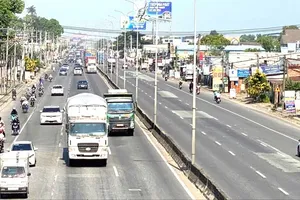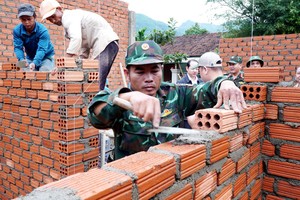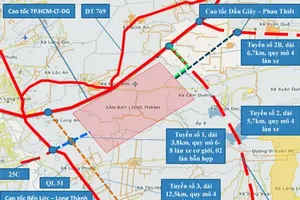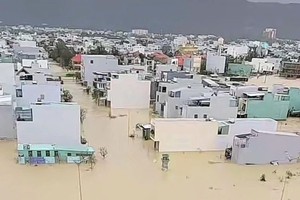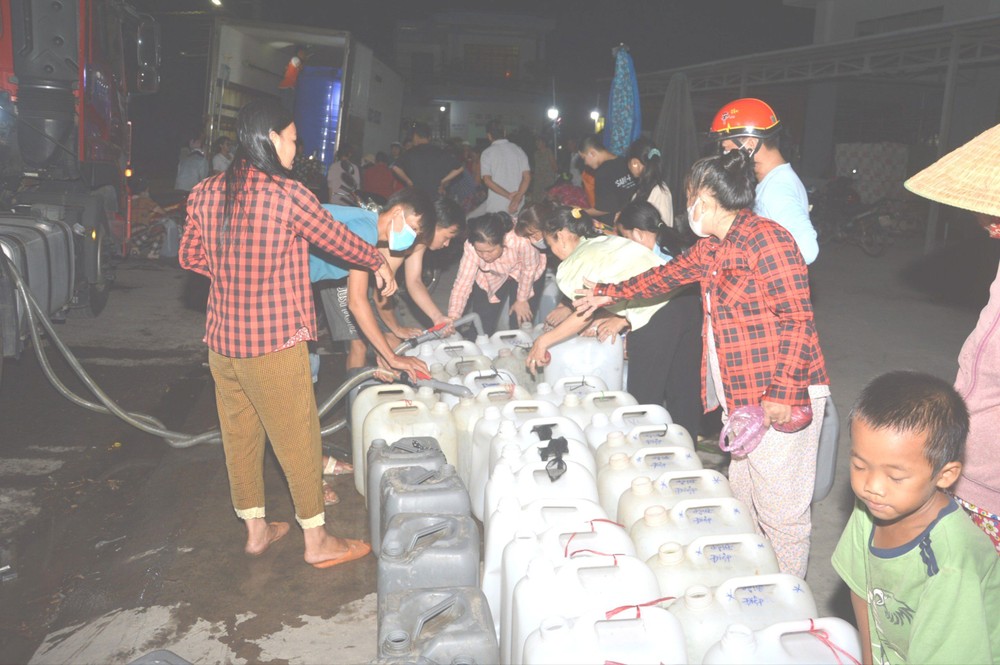
Meanwhile, in the Central provinces, relentless heat and inadequate irrigation have resulted in fish fatalities and parched crops in numerous areas.
Skipping showers due to water shortage
Only by visiting Go Cong Dong District (Tien Giang Province) these days, can people understand the hardships and challenges faced by local residents during this coastal area's dry season. Around 11 a.m., under the scorching sun, Muoi Chot, a resident in Nghia Chi Hamlet, Phuoc Trung Commune, was carrying home two buckets of water from the public water source over 200 meters away.
Glancing at the buckets, she sighed dejectedly, "This morning, I had to make three trips just to fetch water, but each time, I could only manage to fill about half a bucket due to the crowd. It is nearly noon, yet our family has not eaten anything as we are still awaiting water."
Encountering us at the water collection spot on the evening of April 8, Nguyen Thi Lan, who resides in the same village as Muoi Chot, shared that most of the drilled wells in this area had been dry for the past two months. The local authorities have set up five water tanks at two public points for people to come and collect water for their needs. However, water is not always available there due to the large number of people coming to collect it. On days when water is not available, she has to buy water for cooking, and the whole family has to go without bathing.
In the communes of Kieng Phuoc, Gia Thuan, Tan Phuoc in Go Cong Dong District, and Binh Dong in Go Cong Town, along the roads and in every hamlet and village, people are seen carrying buckets and cans to fetch water. "Since early March until now, the drought has been severe. Some days, I can only wait to go fetch water. Work has been stalled, and daily routines and meals are disrupted. Never before have residents experienced such a struggle due to water scarcity like now," shared Trinh Thanh Hung, a resident of Tan Phuoc Commune.
Fish dying, crops burning, and withering
In recent scorching days, the intense heat has led to continuous and unusual occurrences of fish deaths along the O Giang River in Hai Phong Commune, Hai Lang District, Quang Tri Province.
Meanwhile, in Truong Son Commune in Quang Ninh District, Quang Binh Province, the drought has caused over 5 hectares of peanuts grown by the Bru-Van Kieu ethnic people to wither and perish completely. In the mountainous district of Tuyen Hoa (Quang Binh), the blazing sun has inflicted heavy damage on over 60 hectares of corn, ready for harvest. Despite the locals' efforts to find irrigation water, lakes and ponds have dried up, causing the area of dried-up corn to enlarge.
Despite the intense midday sun in April, residents of Ham Can Commune in Ham Thuan Nam District, Binh Thuan Province, brave the heat on their motorbikes to transport plastic containers to a nearby pond with murky water, collecting water for their daily needs. Nguyen Thi Sen, a resident of Ham Can Commune, shared, "I can only manage to make three to four trips a day to fetch water for our household needs on my motorbike; any more than that, and I will not have enough money for fuel."
Water for household use is already scarce, and water for production is even scarcer. The Ba Bich and Linh rivers, which supply water for production to the My Thanh and Ham Can communes, have dried up. Many reservoirs in these areas are completely dry in some places, while only a small amount of water remains in others. From the beginning of 2024 until now, nearly 130 hectares of farmland in My Thanh Commune cannot be cultivated with any crops. In Ham Can Commune, hundreds of hectares of agricultural land have also been abandoned due to the inability to find irrigation water.
By early April 2024, the water level in Binh Thuan Province's irrigation reservoirs merely reached 31.7 percent of their design capacity, down from the same period the previous year by 38.85 million cubic meters. Currently, agricultural production areas are being affected by drought and water shortages in the province, with 365 hectares experiencing damage and 1,175 hectares at risk of damage due to drought and water scarcity.
In Binh Phuoc Province, there are 76 irrigation works, dams, and reservoirs with a designed capacity to irrigate over 9,286 hectares of crops and provide a water supply for daily life and industry of 133,642 cubic meters per day. However, due to prolonged drought, most of these reservoirs and dams have seen decreases, with the storage capacity ranging from only 32 percent to 45 percent.
The scorching sun has caused severe water shortages for over 1,500 households in the province. The agricultural sector has been mobilizing people to dredge ponds and reservoirs to increase water storage capacity for daily use, promote the application of water-saving irrigation methods, arrange water transport to areas with water shortages, and drill new wells to supply water for daily life to local people.
Long-lasting scorching heat expected
On the afternoon of April 8, in Hanoi and Northern Vietnam, the weather was generally chilly and cool with some places experiencing light rain in the early morning and dry conditions in the afternoon. Meanwhile, the National Center for Hydro-Meteorological Forecasting (NCHF) reported that Southern and Central Highlands regions continue to endure widespread intense heat, with temperatures ranging from 35-36 degrees Celsius. Notably, the temperature reaches 36.8 degrees Celsius in Ayunpa (Gia Lai), 36.5 degrees Celsius in Dong Phu (Binh Phuoc), 36.3 degrees Celsius in Tay Ninh, and 36.3 degrees Celsius in Thu Dau Mot (Binh Duong).
Due to the prolonged widespread heat, air humidity has dropped to only 45-50 percent, leading to intense evaporation and a sultry environment. According to meteorological experts, the Southern, Central Highlands, and Central Coastal regions are directly affected by the subtropical high-pressure system in the Philippines, resulting in prolonged heat for many days. Specifically, on April 9 and 10, the Central Highlands and Southern regions will continue to experience widespread heat, with many areas enduring scorching temperatures exceeding 37 degrees Celsius and humidity levels ranging from only 40 percent to 50 percent.
According to Ph.D. Hoang Phuc Lam, Deputy Director of the National Center for Hydro-Meteorological Forecasting, and some meteorological experts, the current El Nino has only transitioned to a neutral state. It is not until July-August that it will shift to La Nina. Therefore, in the immediate future, it will continue to cause strong heat in April and May in the Southern regions.
The average temperatures nationwide are expected to be higher than the multi-year average by about 1-2 degrees Celsius. This year, the rainy season in the South will arrive late, forecasted to start from late May to early June. Meanwhile, in the North, from May to June is the period when the Western low-pressure system develops strongly. The forecast for the summer of 2024 suggests a higher possibility of more intense and prolonged heatwaves compared to the multi-year average. On average, there are 15 heatwaves nationwide each year.
In more detail, the NCHF indicates that in the Northwestern region, heatwaves occur from April to July, peaking in May and June. In the Northeastern region, hot spells span from May to August, reaching their peak in June and July. In the area from Thanh Hoa to Thua Thien Hue, heat spells persist from April to August, with the peak in June and July. For the area from Da Nang to Khanh Hoa, hot weather occurs from May to August, with the highest intensity in July. In the Southern region, April currently marks the peak of heatwaves, with the intensity expected to diminish further in May.
Public water tap opening for community use
According to the Department of Agriculture and Rural Development of Ben Tre Province, there are currently 67 operational clean water plants in the province with a total capacity of 10,500 cubic meters per hour. However, severe saltwater intrusion has adversely impacted the water sources of these plants, posing a risk of water shortages for approximately 25,000 households in the province.
The Provincial People's Committee of Ben Tre has instructed water plants equipped with RO filtration systems to intensify their operations and promptly distribute water to residents. Plants exceeding salinity limits are urged to actively collaborate with those having freshwater (within limits) to exchange and connect water sources, ensuring an adequate supply of fresh water for residents. Water plants affected by salinity and unable to connect to freshwater sources must transport freshwater to provide residents with sufficient water for daily use. Businesses and affected water plants are encouraged to share and reduce water prices for residents.
The province of Tien Giang has also instructed the People's Committees of districts and towns in the Eastern region to open public water taps. Presently, 101 taps have been opened, providing a total water volume of over 6,344 cubic meters in severely water-deficient areas. Tien Giang Water Supply Company has equipped and transported 63 water tanks to provide free water to residents in some critically water-deficient areas in the downstream area. They have also organized forces and vehicles to deliver free water to households living in remote areas, the elderly, and those unable to fetch water themselves.
Military provides water distribution
In recent days, hundreds of households in the drought-hit commune of Bai Bac in Thoi Binh District, Ca Mau Province, were overwhelmed with happiness upon hearing the news that Military Region 9 is dispatching vessels to carry water to supply them.
Not until 9 a.m. on April 8 did the transport ship of the Brigade 659, Logistics Department (Military Region 9) arrive, but, since early morning, residents had been mobilizing boats, bicycles, motorbikes, and carts laden with plastic containers, barrels, water tanks, and buckets to line both sides of the riverbank and the bottom of the Trem River, the section passing through Thanh Tung Hamlet, Bai Bac Commune.
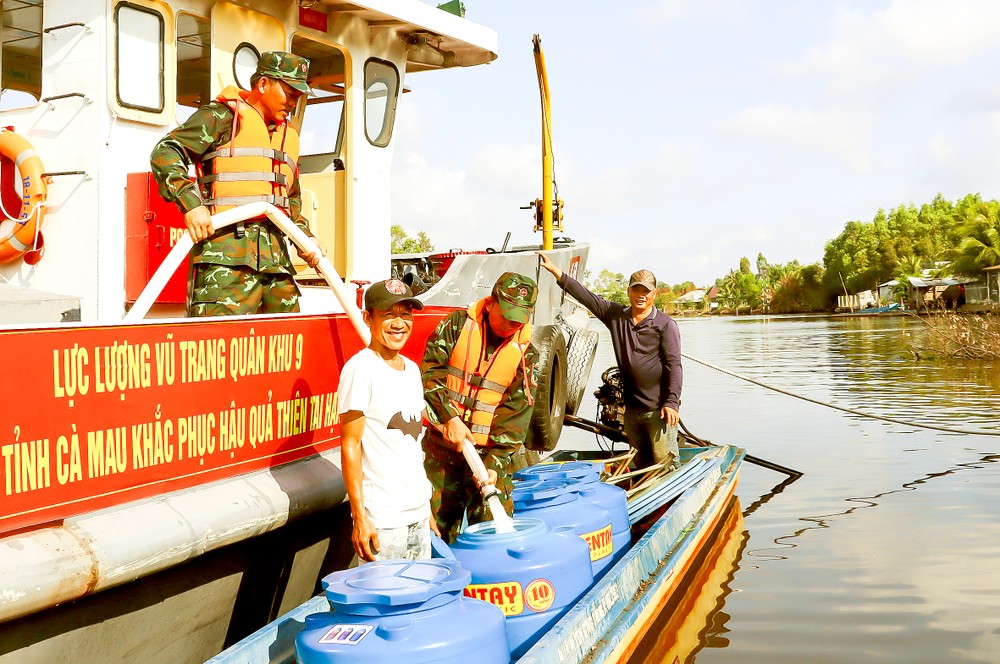
Nguyen Thi Dam, from Hamlet 18, beamed with joy, "My husband and I rode our motorbike here with plastic containers since 5 a.m. Our family of six spends over VND700,000 per month on water. Despite being very thrifty, even utilizing water from bathing, laundry, and dishwashing for watering vegetables, we still do not have enough water for daily use. In Bai Bac Commune, since the start of the 2024 dry season, nearly 500 local households have had to purchase water from boats elsewhere, at prices ranging from VND50,000 to VND70,000 per cubic meter, but water is not always available."
As he lifted a 20-liter water can from the riverbank onto the motorcycle seat for a resident, Mr. Nguyen Tien Ngoan, Deputy Commander of the Military Command of Bai Bac Commune, said that they had cleared the riverbank to allow transport boats to access farther into the hamlet. That morning, the Bai Bac Commune's Militia Team had mobilized 20 officers and soldiers to come there and assist those in need, particularly the elderly, in fetching water and transporting it back home.
Colonel Tran Ba Loc, Political Commissar of the Logistics Department of Military Region 9, reported that on April 8, ships delivered 1,700 cubic meters of water to assist the residents of Bai Bac Commune. The unit also donated hundreds of water tanks, plastic barrels, and plastic containers to help needy households store water. In the coming days, the Logistics Department will continue to transport freshwater to support the people in U Minh District (Ca Mau) and several other coastal areas.
Ensuring access to daily water needs
On April 8, Prime Minister Pham Minh Chinh issued Directive No.34/CD-TTg regarding the concentrated effort to ensure the provision of water for daily use for residents during peak periods of saltwater intrusion in the Mekong Delta region.
The Prime Minister instructed the Ministers of Agriculture and Rural Development, Natural Resources and Environment, Construction, Information and Communications, and the Chairpersons of People's Committees of provinces and cities in the Mekong Delta to devise specific and suitable plans to guarantee access to drinking water for residents, firmly preventing any instances of water shortage.
The Chairpersons of People's Committees of provinces and cities will be held responsible before the Prime Minister if a situation where residents lack access to drinking water occurs.



